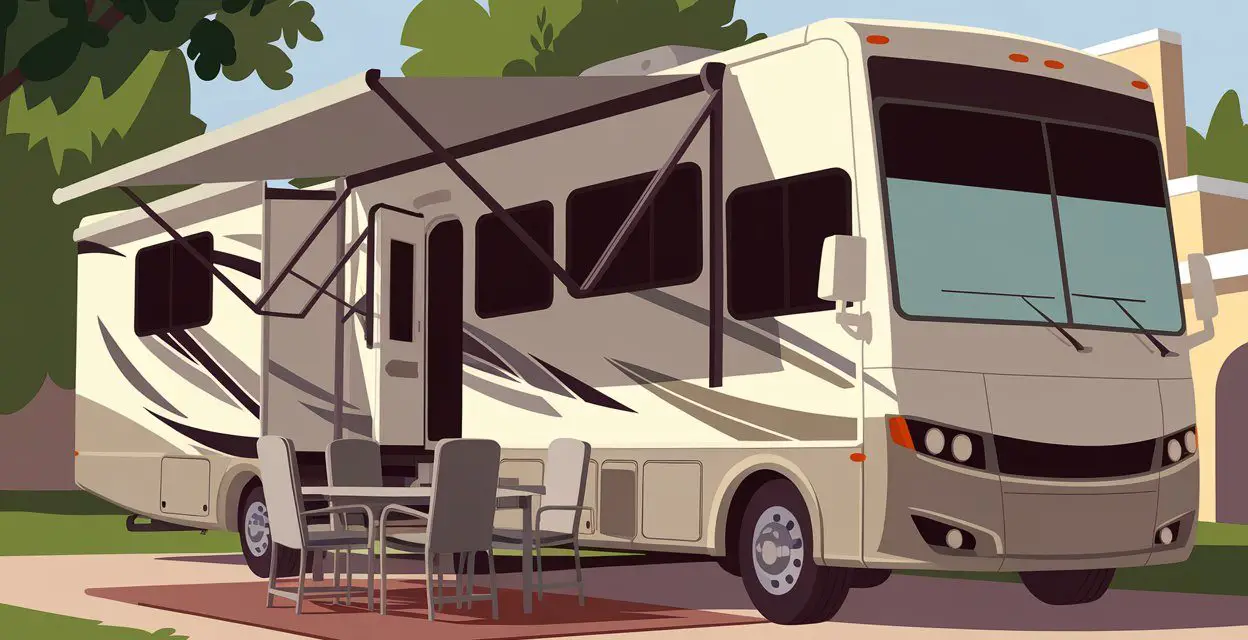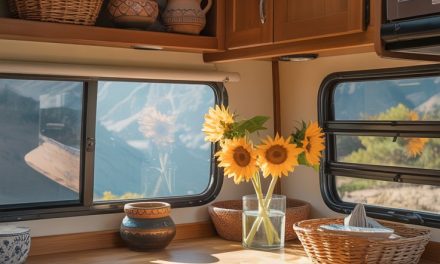Would you like to save this article?
Are RV slide outs reliable, or do they give you more trouble than extra space? These moving rooms can make your motor home or travel trailer feel just right for the rv lifestyle and are now in almost every new model except the tiny campervans.
This guide shows how different slide-out systems work, lists common problems like leaks and jams, and offers practical rv maintenance tips to keep things running smooth. Stick around if you want fewer headaches at campgrounds next trip!
Key Takeaways
- RV slide-outs, like rack and pinion or Schwintek systems, add extra space and comfort. Each type has unique strengths. For example, rack and pinion slides are seen in models from Thor Industries and Winnebago because they handle more weight with fewer parts.
- Common issues include mechanical failures (like worn gears or dead motors), water leaks from old seals, and alignment problems—especially with Schwintek slides. Many cable slide-out problems were reported in 2015–2016 but improved since then due to better maintenance by owners.
- Proper installation is very important for reliability. Poorly installed slide-outs can fail quickly. Always follow the manufacturer’s instructions or hire a professional if needed; this step saves money on repairs later.
- Stick to each slide-out’s weight limit! Too much stuff causes stress on the system and leads to breakdowns over time.
- Regular maintenance matters. Lubricate moving parts every few months, check seals for cracks often, clean tracks after trips, and fix any small issue right away. These simple steps help your RV stay trouble-free during family travels or full-time living.
Types of RV Slide-Outs
Slide outs come in many shapes and systems, from simple gear-based setups to powerful hydraulic pushes. Different models give your recreational vehicle more room, but each has its own quirks with things like the rack and pinion system or Schwintek guides—knowing these can help shape your travel trailer adventures.
Rack & Pinion Slides
Electric through-frame slides, known as rack and pinion systems, lead the pack for reliability in recreational vehicles. You see these tough slide-outs often in travel trailers and motor homes from top RV manufacturers like Thor Industries and Winnebago.
With fewer moving parts than most other types, they need less maintenance. If your battery goes out on a camping trip, you can even use a manual override to close or open them; no fancy tools needed.
Their solid build handles daily wear well, making full-time RVing smoother for many families. They handle heavier slide-out weight compared to cable slides or worm-gear designs. Affordable yet strong, this design keeps costs low while giving peace of mind to anyone who values simplicity in their rv lifestyle.
Interested in lightweight RVs? Up next are In-Wall Slides, another big player in today’s RV industry.
In-Wall (Schwintek) Slides
In-Wall (Schwintek) slides are popular in lightweight RVs and travel trailers. They use two electric motors, which make them compact and space-efficient. This design helps improve fuel economy while on the road.
These slides fit well into the walls of your RV, creating a seamless look when they’re closed.
While they offer many benefits, Schwintek slides can face challenges. Misalignment is a common issue due to their reliance on electric power. You must check them regularly to avoid problems during trips.
Keeping up with maintenance will help ensure these slides remain reliable as you enjoy your full-time RVing lifestyle or weekend getaways in fifth wheels or motorhomes.
Hydraulic Slides
Hydraulic slides use a motor and pump assembly. They usually have two rams for smooth movement. This setup makes them strong enough to handle larger, heavier slide rooms. Many RVs with these systems are bigger and heavier, like some fifth wheels or travel trailers.
These slides can be more complex than other types but offer great support for your living space. If you enjoy the full-time RV lifestyle, hydraulic slides might be the best choice for you.
Just keep in mind their maintenance needs to keep everything working well on your adventures!
Cable Slides
Cable slides use eight cables to operate. They are lightweight and cost-effective for deep slides in RVs. These systems can save space while offering flexibility in design, especially for travel trailers and fifth wheels.
Still, they need regular upkeep. Cables might stretch over time which can lead to issues if not addressed.
There were significant problems reported with cable slides during 2015-2016, but these are less common today due to better maintenance awareness among RV owners. Proper installation is key; any misstep can cause alignment problems or mechanical failures later on.
Keep track of their weight limits too! Be sure to check those cables regularly as part of your RV maintenance routine on the road or at home.
Factors That Affect the Reliability of RV Slide-Outs
Several things can affect how well your RV slide-outs work. First, a good installation is key. If they’re not put in right, problems will come up fast. Next, you need to stick to the weight limit on those slides.
Overloading them spells trouble! Also, how often you use them matters too. Too much action can lead to wear and tear. Want more tips on keeping those slide-outs rolling smoothly? Keep reading!
Proper Installation
Proper installation is key for your RV slide-outs. If it’s not done right, you might face problems later on. A poorly installed slide-out can lead to mechanical failures and alignment issues.
These problems can make your travel trailer less enjoyable.
Hiring a professional is smart for complex systems like hydraulic slides or rack and pinion slides. They know the ins and outs of these installations. This step helps keep everything in good shape, ensuring the reliability of your RV during all those camping trips ahead!
Weight Limit Adherence
After looking at proper installation, let’s talk about weight limit adherence. Each RV slide-out has a specific weight limit. Exceeding this can lead to mechanical failures. It puts stress on the system and could cause serious problems down the line.
Always check your RV slide-out’s weight limits before loading it up. This is especially true for heavier items in your travel trailer or fifth wheel. Keep an eye on weight distribution too; it’s key for smooth operation.
Follow these tips, and you’ll enjoy a more reliable RV lifestyle!
Frequency of Use
Using your RV slide-out often can be a double-edged sword. Frequent use leads to wear and tear, just like driving a car too much. If you only use it now and then, it might get stiff or stuck over time.
This is where regular usage helps. It keeps the mechanical parts working smoothly.
Traveling full-time? Use that slide-out regularly! Doing so prevents issues from cropping up later. Don’t let those components seize up on you; keep them moving. Your RV lifestyle should involve ease and comfort, not headaches with broken equipment.
Regular maintenance will help keep everything in check—a clean track means a happy slide-out!
Common Issues with RV Slide-Outs
Slide-outs can face several challenges. Mechanical failures are common and might leave you stuck. Water leaks can ruin your day, damaging your RV’s interior. Sometimes alignment issues pop up, making it hard to open or close the slide-out properly.
You don’t want to deal with these headaches while camping! It’s key to keep an eye on these problems before they become big troubles.
Mechanical Failures
Mechanical failures can really impact your RV lifestyle. They often occur if you don’t keep up with maintenance. For example, motors can stop working over time. Gears may wear down, making it hard for the slide-out to move in and out smoothly.
These issues are common but avoidable.
Regular checks can help catch problems early. Simple tasks like lubricating parts can make a significant difference. Keep an eye on how the slide functions after use too; if something feels off, it might be time to inspect it closely or call in a professional from the RV industry.
Taking care of things now saves you trouble later while you’re out enjoying your travel trailer or fifth wheel adventures!
Water Leaks
Water leaks can be a real pain. They often come from the rubber seals around your RV slide-outs. These seals can wear out over time, especially due to UV rays from the sun. A small leak might seem harmless at first, but it can lead to big problems later on.
Water damage inside an RV is no joke; it can ruin floors and walls.
You need to keep an eye on those seals and gaskets. Regular checks help catch issues before they grow into costly repairs. Proper sealing is key in preventing leaks and keeping your space dry while you enjoy the RV lifestyle.
Next up are some common issues with RV slide-outs that you should know about.
Alignment Problems
Alignment problems can be a real hassle with RV slide-outs. Misalignment often happens due to poor installation or frequent use. Schwintek slide-outs, in particular, are prone to this issue.
If your slide-out is not aligned properly, it may not open or close smoothly. This can lead to further damage and costly repairs.
To avoid these issues, conduct regular alignment checks. You want everything running as it should for stress-free travels in your travel trailer or fifth wheel. Keep an eye on how the slide-out moves every time you set up camp; if something seems off, take action right away! It’s simple: maintaining proper alignment helps ensure reliability and longevity of your RV slides; trust me, you’ll thank yourself later!
Maintenance Tips for RV Slide-Outs
Keep your RV slide-outs in top shape with a little care. Check the seals and gaskets often; dry spots can lead to bigger problems later. Don’t forget to clean the tracks, too—dirt can get in the way of smooth operation.
Lubricate moving parts regularly for hassle-free use on your adventure!
Regular Lubrication
Regular lubrication is key for your RV slide-outs. It helps prevent wear and tear on the mechanical parts. If you want them to last, you need to keep them well-greased. Follow the manufacturer’s recommendations for the best results.
Electric and hydraulic systems also depend on this maintenance.
You may not think about it often, but a little oil goes a long way in keeping your slide-outs running smoothly. Check these areas at least once every few months. You’ll save yourself from costly repairs down the road.
So, make lubrication part of your routine RV maintenance, especially if you’re enjoying the full-time RV lifestyle.
Inspecting Seals and Gaskets
Check the seals and gaskets on your RV slide-outs often. These rubber parts keep water out and bugs away. Look for cracks or wear signs. If you spot any damage, replace them right away.
Treatments are available to help extend the life of these seals. A little care goes a long way in keeping your RV safe from leaks. Regular checks can save you from bigger problems down the road, making your full-time RVing experience smoother and more enjoyable.
Keeping the Tracks Clean
Keeping the tracks clean is key for smooth operation of RV slide-outs. Debris can block movement and create problems. Every time you set up camp, take a moment to inspect those tracks.
A little dirt can lead to big issues down the road.
Use a brush or a damp cloth to wipe away any buildup. This small task will keep your slide-out reliable and functional. Clean tracks mean less chance of mechanical failures. Make it part of your RV maintenance routine, especially if you enjoy full-time RVing or weekend camping trips in your travel trailer or fifth wheel!
Conclusion
RV slide-outs can be a great addition to your space. They offer more room for living and relaxing. Each type has its pros and cons, so pick one that fits your needs. Regular maintenance is key; check seals, clean tracks, and keep everything well-lubricated.
With proper care, slide-outs can be reliable companions on your adventures!
FAQs
1. How reliable are slide outs in travel trailers and fifth wheels?
Slide outs have become common in the RV industry, especially for the modern RV lifestyle. Most manufacturers use strong rack and pinion systems or similar setups to boost slide out reliability. Still, like any moving part, they need regular rv maintenance.
2. Do lightweight RVs handle slide out weight well?
Lightweight rvs often come with smaller or fewer slide outs to manage weight better. If you pack too much into a small camper, it can strain the system over time.
3. What’s the best way to keep my slide outs working during full-time rving?
Check seals before every trip; watch for leaks after heavy rain or when camping near water. Lubricate gears on your rack and pinion system now and then; dirt buildup is no friend of smooth movement.
4. Can I trust all rv manufacturers with durable floor plans that include multiple slide outs?
Not every company builds things equally solid, so do your homework first. Some brands focus more on rv camping comfort than durability; others pay close attention to longevity even if their maxxforce isn’t top of class.
5. Are there specific maintenance tips for keeping my travel trailer’s slides running smoothly?
Absolutely—clean tracks regularly, avoid operating them while not level at campgrounds, listen for odd noises during extension or retraction, and never ignore sticky movements since those might signal bigger issues ahead for both occasional trips and full-time adventures alike.





